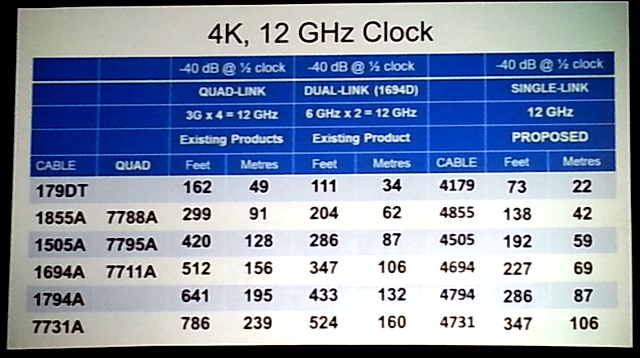Broadcast & Distribution – That’s a question that Stephen Lampen, Belden Multimedia Technology Manager/Product Line Manager for Entertainment Products, is very concerned about.
At the recent SMPTE Conference, he asked the audience during a presentation if anyone would install coax cabling in broadcast facilities going forward. No one raised their hands. He thinks that means that everyone assumes they will be running fiber for 4K. And that has him worried.
For short distance distribution of video, the number of connection options is actually multiplying, with many copper-based solutions available and evolving quickly. But for longer distances – the magic number that Lampen hears is 100 meters – your choices are more limited. And, those options narrow as data rates go up to support 4K production.
The mainstay of broadcast production facilities has been copper coax running SDI signals. As the SDI standard has evolved from SD to HD, and now 4K-UHD, the SDI standard and coax cabling has struggled to keep up. The current 3G-SDI standard supports 1080p 60 fps signals, but to move 4K video, you currently need to use four 3G-SDI cables. And these have to be very carefully matched in length and the four paths perfectly synchronized if you want to get video without glitches.
SMPTE has a roadmap to offer 6G-SDI and 12G-SDI protocols that would run at 6 Gbps and 12 Gbps. These would then require two coax or one coax cable to support 4K at 60 fps. Cable solutions that wrap two or four coax cables together are available from Belden and others, but clearly having one cable is the desire of the broadcasters. But is 12G-SDI over coax practical?
According to Lampen, it is possible, but it will be very challenging. And, it will cost his company millions of dollars to develop the solution – which is why he is concerned about customers looking at alternative solutions like fiber or CAT 5/6 cable.

Lampen says Belden has several existing coax cables that can support 6 Gbps SDI distribution at up to 100 meters, but for 4K you still need its dual cable solution (1694D). But to provide a single cable 4K distribution solution at 12 Gbps, Belden will have to redesign the cable and connector. That means a solid core copper wire, Teflon insulator and two shielding layers. The cable will get bigger too, and designing a connector to support this data rate will be non-trivial as well. Lampen says the company plans to develop the cable by Q1’15, but he does not know when the connector will be ready.
During the Q&A, a number of concerns were discussed. Fatter cables may mean new cable management solutions too, plus the trend is toward smaller connectors – not bigger ones. The cable will be expensive too, and buyers will have to weigh the cost vs. fiber or CAT 5/6. Fiber will not have any foreseeable distance or bandwidth issues, but CAT 5/6 cable does have distance and bandwidth limitations.
While the 6G-SDI and 12G-SDI standards are not yet approved standards, that is probably not going to have too much effect on cable and connector design as the data rates are known.
Plus, test gear is still lacking for development. Lampen would like to have 75 ohm cable, but most test gear is for 50 ohm coax. Plus, the fastest equipment can test at up to 12 GHz – and he would like to test the cable/connector out to 18 GHz.
And you can probably forget about getting flexible coax for 12G-SDI. That requires a braided copper core, and that would give the needed performance.
Finally, he stressed that they have not yet made the cable/connector to support 12G-SDI, and he really needs customers to want to buy this cable. If they build it, will they come? That’s a good question that I don’t think he got the answer to at this event. – Chris Chinnock

